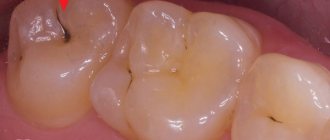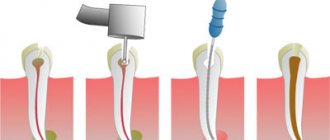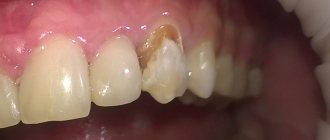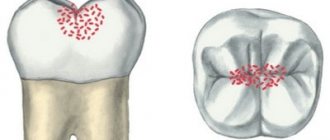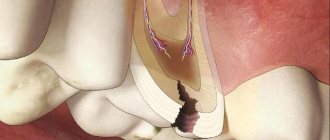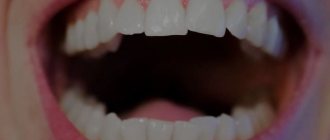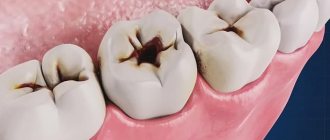If the resulting hole in the tooth is not filled in time, it may collapse and will have to be removed over time. You need to figure out why holes appear in teeth and how to deal with them.
The most basic reason for the appearance of a hole is tooth disease with caries, which first appears as a small dark spot on the tooth enamel. If caries is not treated at the initial stage of its appearance, it can gradually grow, penetrate into the tooth pulp and form a carious cavity. This cavity must be filled so as not to lose the entire tooth. A filling is placed if the tooth is affected by simple caries or complicated caries, or if pulpitis or pericementitis occurs.
Installing a seal
The task of the doctor who has discovered a tooth damaged by caries is:
- drilling out dead tooth tissue and darkened parts of enamel;
- expansion of the carious cavity;
- checking the condition of the pulp;
- preparing the tooth for filling.
The filling process consists of:
- in disinfecting the drilled cavity and drying it;
- installing a medicinal inlay into the tooth canals;
- installation of a temporary filling;
- A permanent filling is installed when a tooth is cured and the lost parts need to be restored.
Weak and strong caries of anterior teeth
Spot
A chalky stain is a clear sign of a lack of minerals and the beginning of the destruction of the enamel structure. They are white in color and respond well to treatment at the initial stage. There may be a reaction to sweets.
Surface
At this stage, the enamel loses its integrity (which is especially noticeable upon probing), and the stain acquires a brownish tint. A painful reaction to temperature and chemical stimuli appears.
Average
The stage at which dentin is affected. A noticeable carious cavity appears on the surface of the tooth; over time, the crown part begins to change color. Severe pain occurs when eating cold and hot food and a reaction to sweets.
Deep
The most severe caries of the front teeth occurs when the deep layers of dentin are damaged. Severe pain from temperature stimuli and a pronounced aesthetic defect are observed.
Types of permanent fillings
- Metal seal. Advantages: long service life, inexpensive cost. Disadvantages: long hardening time, contrasting color with the color of the enamel.
- The cement filling can be phosphate or glass ionomer. Advantages: release of fluoride ions, which prevent the formation of caries. Disadvantages: fragility and short service life.
- Composite fillings are made from an epoxy mixture. Advantages: long service life. Disadvantages: long time to install the filling.
- Plastic fillings are made on the basis of acrylic acid. Advantages: high strength. Disadvantages: the formation of micropores in the filling, through which caries can penetrate.
- Ceramic inlays are used to restore a damaged tooth. Advantages: strength and reliability. Disadvantages: high cost and long installation time.
The appearance of holes in teeth: causes
As such, there are many reasons for the occurrence of holes in teeth due to carious lesions; they are divided into two large categories:
- Maintaining an unhealthy lifestyle: disrupted diet and eating schedule, bad habits (smoking, systematic consumption of large quantities of alcoholic beverages, drug addiction), neglect of the rules of personal hygiene (oral care);
- Category of external causes independent of the person himself: genetic inheritance, gender characteristics, malocclusion.
Among the reasons for these two categories, the most common are:
- Individual physiological characteristics. Often, the formation of cavities in teeth is predetermined by the low quality of their enamel, sparsely set teeth, and malocclusion. If you have “gaps” between your teeth, pay attention to hygiene and be sure to use dental floss after every meal. Remove food debris that may accumulate between teeth to prevent tooth decay and resulting holes. If you have an incorrect bite, this ideally needs to be corrected, since in this case the enamel wears out much faster and the teeth become defenseless against bacteria;
- Climatic conditions of residence can also affect the frequent occurrence of this problem. Bad water, lack of nutrients in the soil - all this not only does not prevent, but even contributes to the appearance of caries in residents of these areas;
- Poor nutrition. If a person actively consumes high-carbohydrate foods, the occurrence of cavities cannot be avoided. Nutrition must be systematized and brought to a stable schedule.
It is worth noting the fact that most often, holes in the teeth appear in women, especially during breastfeeding and pregnancy.
Naturally, it does not happen that a person went to bed in the evening with a completely intact tooth, and woke up the next morning to find a hole in it. The process of cavity formation is gradual:
- Initial stage. The enamel becomes dark; it is important not to skip this stage, since by taking measures (by seeking professional cleaning from a dentist) you can avoid the occurrence of caries. Often, the dentist prescribes the use of a specialized medicated tooth powder, which is used to treat caries much more effectively than toothpastes;
- Stage of superficial damage. The damage extends to the top layer of the tooth. This stage is accompanied by increased sensitivity of the tooth when eating food that is too hot or too cold; there is no painful sensation as such;
- Middle stage. The damage spreads to the dentin, a microscopic hole appears, which can cause the first noticeable discomfort in the form of unpleasant sensations during eating;
- Final stage. The hole becomes noticeable, pain appears, and blood vessels and nerves may be affected. This stage may be accompanied by pulpitis.
What to do when your tooth already hurts?
Immediately contact a dentist who will treat the diseased tooth and, if necessary, install a filling on it.
To prevent the development of tooth pain, you must regularly undergo preventive dental examinations by a dentist, who can diagnose caries at an early stage of development and prescribe dental treatment. Untimely treatment can lead to tooth decay and loss.
Symptoms (how to find a hole)
A hole in a tooth can be detected independently, especially if the case is advanced, when the cavity is clearly visible in the mirror or felt with the tongue.
In addition, symptoms may include:
- The surface of the tooth is characterized by the presence of a dark spot. If a hole has formed on the front teeth, it will become noticeable to the naked eye;
- Drinking cold drinks and foods, as well as sweet, sour or too hot foods causes pain;
- Daily brushing of teeth is also accompanied by painful sensations;
- The appearance of unpleasant and even painful sensations in the process of eating solid foods, as well as meat. Small particles/fibers remain in cavities/holes;
- Often the resulting holes are accompanied by an unpleasant odor from the mouth, since food particles remain in them, which subsequently begin to rot and emit a characteristic stench;
- There is food left between the teeth and in the hole; getting rid of such a symptom is not easy.
If the lesion has already reached the dental nerve, the neurovascular bundle becomes inflamed, and acute, unbearable pain appears, in which case urgent dental intervention is necessary.
What to do
Of course, you shouldn’t sit and wait for the pain and discomfort in the area of a tooth overgrown with gums to go away on its own. It is best to immediately contact a specialized dental clinic for medical advice. Only he will be able to conduct a comprehensive examination of the oral cavity, prescribe the necessary tests, conduct an X-ray examination and prescribe the correct treatment.
As a rule, a broken tooth that is overgrown with soft tissue is carefully removed. This requires making an incision in the gum. If the tooth is healthy, then after opening the hole the doctor can install an artificial root and prosthesis into it.
If it is not possible to save the tooth, then a procedure is performed to extract its root system. To do this, the specialist uses a special tool called an elevator, with which he cuts the top of the unit and gradually brings it to the surface. Such manipulations are carried out under local anesthesia and do not take much time. After extraction of a diseased tooth, a medicinal drug can be applied to the wound, which promotes faster healing. The stitches are removed after a few weeks.
When there is black caries, but it is still not treated
Many people have encountered a situation where a doctor, during an examination, confirmed the presence of the initial stage of caries, but refused to treat it according to the standard regimen. Why is this happening? The thing is that during drilling of dentin, much more hard tissue is damaged than it seems at first glance. But it is impossible to install a seal without drilling.
Trying to avoid unnecessary destruction of the crown, the doctor does not want to drill into black caries at the spot stage. Very often its dimensions do not change at all for a long time. The spot itself does not cause a person any discomfort. If you brush your teeth thoroughly after each meal, use high-quality toothpaste and remineralizing dental gel, you can maintain caries at its original size for several years, that is, avoid its increase.
Therefore, if the dentist says that there is no need to touch the tooth yet, you should listen to his words. This is a way to preserve hard tissues without changing their volume for the coming years.
Consequences
If the root and part of the tooth are left inside the gum tissue, some complications may occur. Inflammation in the pulp chamber can begin as a result of dirt and infection; this process is accompanied by severe pain, the appearance of purulent discharge, rotting, etc. To avoid sepsis, surgical removal of the root and nerve endings is recommended.
Another dangerous disease is periodontitis. In the absence of timely treatment, the unit can become very loose; it is surrounded by voids where germs, food particles, and infection can get in. In this case, the root moves away from the coronal part quite quickly and it becomes almost impossible to save it. If the problem is not corrected in time, there is a high risk of damage to other organs and even blood poisoning. The latter threatens with very serious complications and is dangerous to human health.
Another common occurrence is when a previously filled tooth breaks and particles of the composite get into the hole. These particles can react with tissues, which leads to the development of inflammation. In this case, not only the root of our broken tooth can become inflamed, but also nearby units. If inflammation is left unattended by a specialist for a long period of time, a cyst may appear.
The main causes of pathology
There are a number of main reasons why a tooth can become overgrown with soft tissue. The most common reason is negligence towards periodontal tissues, refusal to visit the clinic after breaking off part of the crown. There are also quite often cases when a wisdom tooth that has not fully erupted is covered with gum on top. In the future, this figure eight can exert strong pressure on the entire dentition, which will lead to a gradual change in the bite and the appearance of serious orthodontic pathologies.
The patient may also encounter a similar situation when refusing to remove the root system of a broken tooth. As a result, a small piece of the top, as well as the root, remains under the gum, and over time they can begin to hurt and become inflamed.
It is important to note that a person’s bad habits, poor diet, consumption of junk food, chronic diseases and lack of oral hygiene can lead to teeth becoming more sensitive and brittle. As a result, the slightest pressure will be enough to cause part of the crown to break off.
Caries between the front teeth, at the root and on the cutting surface
Caries between front teeth
Interdental caries of the anterior teeth is considered one of the most common. It, as the name suggests, affects the area between the teeth. In this place, the enamel is thinnest, and due to food debris, there is a high concentration of bacteria. Tooth decay on the lower front teeth is usually less common.
Root caries of anterior teeth
It is localized in the area of the neck of the tooth, hence the name. The lesion usually begins with a yellowish spot, which later turns brown. In the later stages, the disease significantly destroys tissue, so treatment of cervical caries of the anterior teeth must be timely.
Contact
Most often occurs in children during the formation of baby teeth. In adults, this type of lesion occurs due to a genetic predisposition or a lack of minerals and other necessary components for the health of the enamel. Contact caries of the anterior teeth can appear when the process on the diseased tooth affects the neighboring one and “infects” it.
Prevention of caries
The easiest way to avoid fillings or minimize the number of fillings is to visit your dentist regularly. This should be done at least once every six months. Simple tips will also help keep your teeth healthy:
- Careful hygiene. You need to brush your teeth with a high-quality brush and toothpaste at least twice a day.
- Using dental floss will help remove plaque from hard-to-reach places.
- Rinsing with special liquids will also help keep your gums healthy, which play a huge role in keeping your mouth healthy.
- A balanced diet will help ensure you have enough vitamins and minerals to keep your teeth strong.
Now we treat teeth even better!
Treatment, re-treatment of canals, elimination of caries under a microscope without damaging healthy tooth tissue.
We do everything to save your own tooth. Consultation with specialists is FREE!
More details
Treatment of holes
Depending on the stage of the disease and the reason for the formation of the hole, a person may simply not be bothered by this cavity or may make itself felt by severe pain with fever. The hole must be healed with the help of a dentist. But if you still can’t get to the dentist’s office, you can relieve the pain at home.
Emergency help at home
If pain occurs, you should immediately brush your teeth. This will remove food debris from the mouth. Next, you should take any analgesic drug. The medicine will also help in case of fever.
If swelling is suddenly observed, it can be reduced by rinsing with soda. Or apply a piece of ice to the sore spot for 15-20 minutes.
Very often people resort to our grandmothers' recipes. The older generation claims that the following will help with initial pain in the tooth:
- A piece of lard, garlic, beets and bee propolis attached to the tooth.
- Normal tears, so you need to cry. Tears will relieve pressure in the jaw and thereby reduce the pain slightly.
- Massage the ear from the side of the diseased tooth.
- Gargling with herbal decoctions.
- Rubbing the sore spot with plantain juice.
Independent measures will only alleviate the condition, but will not cure the tooth. If a tooth stops seriously bothering you, this does not mean that the disease has gone away. The disease simply began to occur hidden. It went to the very depths and became chronic. In any case, you will have to go to the dentist.
Doctor's appointments
A hole in the teeth is treated according to the same scheme:
- First stage: thorough treatment of the oral cavity. Here the doctor removes plaque and tartar from the diseased tooth or from the entire oral cavity.
- Second stage: prick or injection of an analgesic. This kind of pain relief is necessary. Under its influence, the patient’s panic fear of treatment goes away, he does not feel pain and thereby allows the doctor to calmly do his job.
- Stage three: removal of infected tissue. Removal is carried out throughout the entire tooth cavity using special dental devices. Next, the doctor coats the walls of the exposed tooth with a bur or antiseptic. As a result of this action, the growth of bacteria and further relapse of the disease stops.
- Stage four: drilling out the cavity to install the filling. This is necessary so that the new installed material fits tightly into the tooth.
- Fifth stage: application of filling material or protective seal. They try to match the material as closely as possible to the color of the patient’s natural teeth. If suddenly the patient’s tooth has been affected by deep caries, then a therapeutic pad is placed at the bottom of the cavity. It will relieve inflammation from the nerve. Read about how to kill a nerve in a tooth here.
- Stage six: adjusting the filling to the shape of the tooth. This action helps the patient not to experience discomfort when chewing in the future.
Complications from the hole
It has been said that caries is the starting point for the formation of a hole. If it is not treated in time, pulpitis will begin, then the disease will develop into periodontitis. Pulpitis and periodontitis are often treated using surgical methods.
A feature of pulpitis is that the pulp chamber is opened. The person begins to suffer from severe pain. In this case, the occurrence of pain does not depend on irritating factors. The pain wears him down the most at night. Pulpitis can exist in two forms: acute and chronic. If this disease is not treated, it will develop into periodontitis.
With this disease, an abscess forms. If suppuration affects the underlying tissue, osteomyelitis will occur. If a lesion containing pus breaks through, blood poisoning may occur.

